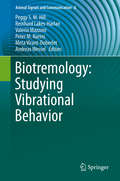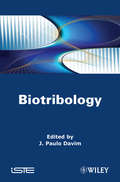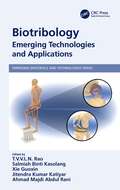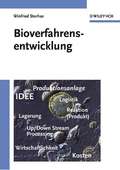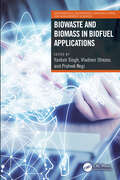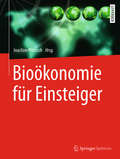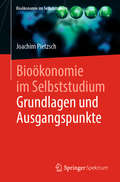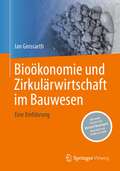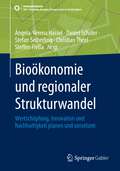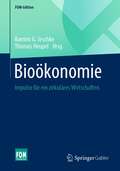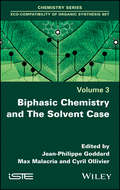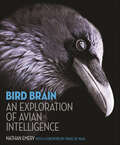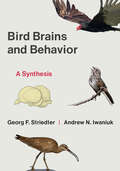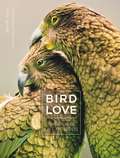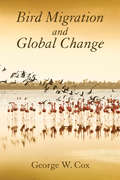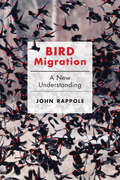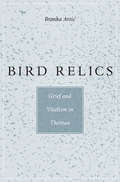- Table View
- List View
Biotremology: Studying Vibrational Behavior (Animal Signals and Communication #6)
by Andreas Wessel Peggy S. M. Hill Reinhard Lakes-Harlan Valerio Mazzoni Peter M. Narins Meta Virant-DoberletThis volume is a self-contained companion piece to Studying Vibrational Communication, published in 2014 within the same series. The field has expanded considerably since then, and has even acquired a name of its own: biotremology. In this context, the book reports on new concepts in this fascinating discipline, and features chapters on state-of-the art methods for studying behavior tied to substrate-borne vibrations, as well as an entire section on applied biotremology. Also included are a historical contribution by pioneers in the field and several chapters reviewing the advances that have been made regarding specific animal taxa. Other new topics covered are vibrational communication in vertebrates, multimodal communication, and biotremology in the classroom, as well as in art and music. Given its scope, the book will appeal to all those interested in communication and vibrational behavior, but also to those seeking to learn about an ancient mode of communication.
Biotribology
by J. Paulo DavimTribology is the “science and technology of interacting surfaces in relative motion” and encompasses the study of friction, wear and lubrication. By extension biotribology is usually defined as the tribological phenomena occurring in either the human body or in animals. Therefore, it is possible to consider tribological processes that may occur after implantation of an artificial device in the human body and the tribological processes naturally occurring in or on the tissues and organ of animals. Animals, including humans, possess a wide variety of sliding and frictional interfaces. The authors aim to provide some advances in research in biotribology. They cover several aspects of biotribology such as tribology of synovial joints and artificial replacements; wear of screws and plates in bone fractures repair; wear of denture and restorative materials; friction of the skin and comfort of clothing; wear of replacement heart valves; tribology of contact lenses and ocular tribology; biotribology on the microscale and nanoscale levels, etc. This book can be used as a research text for final undergraduate engineering courses (for example, materials, biomedical, etc.) or for those studying the subject of biotribology at the postgraduate level. It can also serve as a useful reference for academics, biomechanical researchers, biologists, chemists, physicists, biomedicals and materials engineers, and other professionals in related engineering, medicine and biomedical industries.
Biotribology: Emerging Technologies and Applications (Emerging Materials and Technologies)
by Jitendra Kumar Katiyar Salmiah Binti Kasolang T.V.V.L.N. Rao Ahmad Majdi Abdul Rani Xie GuoxinBiotribology includes tribological phenomena of natural and implant surface interactions under relative motion in the human body. Biotribology: Emerging Technologies and Applications disseminates ideas and research trends in biotribology and presents pioneering recent research advances impacting the field, focusing on the roles of mathematics, chemistry, physics, materials, and mechanical engineering. Discusses lubrication of joint replacements, computational modeling of biotribology and multibody biomechanical models Describes metal-organic frameworks, medical friction pairs, and electrochemical techniques to tribocorrosion tests Covers state of the art and future technological developments and applications, as well as challenges and opportunities Biotribology is an important and growing field, and the topics covered in this book will be of great interest to the international tribology community, appealing to readers working in the fields of materials science, biomedical engineering, biotechnology, mechanical engineering, and related areas.
Biovalorisation of Liquid and Gaseous Effluents of Oil Refinery and Petrochemical Industry (IHE Delft PhD Thesis Series)
by Samayita ChakrabortyA bidirectional approach of detoxifying the liquid and gaseous effluents of oil refineries is elucidated in this thesis. Liquid effluents of oil refineries contain selenium oxyanions and phenol, while gaseous effluents contain CO/syngas. To remove the phenol and simultaneously reduce the selenite oxyanions, a fungal-bacterial co-culture of Phanerochaete chrysosporium and Delftia lacustris was developed. Two modes of co-cultures of the fungus and the bacterium were developed. Both cultures were investigated for phenol degradation and selenite reduction. In order to valorize the CO/syngas by bioconversion techniques. an anaerobic methanogenic sludge was acclimatized to use CO as the sole carbon substrate to produce acetic acid, butyric acid, and hexanoic acid. Later, the acids were metabolized at lower pH, producing alcohols ethanol, butanol and hexanol, confirming the successful enrichment strategy. The next experiment focused on the absence of the trace element tungsten, and consecutively selenium on the previously CO acclimatized sludge under the same operating conditions. An in-situ synthesized co-polymeric gel of N-ter-butyl-acrylamide and acrylic acid was used to recover ethanol, propanol and butanol from a synthetic fermentation broth. The scope of repeated use of the gel for alcohol recovery was investigated and 98% alcohol was recovered.
Bioverfahrensentwicklung: Praxisbeispiele Für Auslegung, Betrieb Und Kostenanalyse
by Winfried StorhasZukunft sichern durch Nachhaltigkeit? Bioverfahrenstechnik bedeutet einen wichtigen Schritt auf dem Weg dorthin. Sie ersetzt klassische chemische Syntheseverfahren durch nachhaltige biologische Verfahren und vereint unterschiedliche Gebiete aus dem naturwissenschaftlichen und ingenieurtechnischen Bereich. Mit diesem Buch wird allen, die an der Entwicklung biotechnologischer Prozesse beteiligt sind, ein Werk an die Hand gegeben, das die einzelnen Aspekte der Bioverfahrensentwicklung darstellt und zu einem Gesamtbild zusammenfugt: Mikrobiologie, Molekularbiologie, Zellbiologie und Biochemie sowie die ingenieurtechnischen Bereiche Elektrotechnik, Informatik, Steuerungstechnik, Maschinenbau und Verfahrenstechnik - jeweils aus dem Blickwinkel der Verfahrensentwicklung betrachtet. Mit klaren, praxisorientierten Verfahrensbeispielen werden die beschriebenen Prozesse erklart. Im Vordergrund stehen dabei Verfahren, die in der Industrie eine wichtige Rolle spielen. Wirtschaftlichkeitsbetrachtungen, die bei der Entwicklung eines Verfahrens schon im Anfangsstadium eine entscheidende Rolle spielen, ist ein ganzes Kapitel gewidmet. Die zweite Auflage des Erfolgstitels von 2003 ist ein Muss fur alle Studenten der Biotechnologie und Verfahrenstechnik und das ideale Nachschlagewerk fur Ingenieure der Verfahrenstechnik, Biochemiker und Pharmazeuten. Stimmen zur 1. Auflage: 'Das Buch ist ein nutzlicher Begleiter in der taglichen Praxis und kann sowohl als Lehrbuch wie auch als Nachschlagewerk verwendet werden.' BIO WORLD, Dr. C. Andretta 'Dieses Buch richtet sich an alle, die einen Beitrag zur Entwicklung eines biotechnologischen Prozesses leisten mochten. Es informiert sehr ausfuhrlich uber die Bioverfahrensentwicklung und ermoglicht, sich ein Gesamtbild zu verschaffen. Es ist auch als Lehrbuch fur das Gebiet Bioverfahrenstechnik gut geeignet.' F & S (Filtrieren und Separieren)
Bioverfahrensentwicklung: Praxisbeispiele Für Auslegung, Betrieb Und Kostenanalyse
by Winfried StorhasBioverfahren haben sich in vielen Bereichen als überlegene Alternativen zu klassischen Produktionsverfahren etabliert, und ihre Bandbreite wird immer größer. Die Biotechnologie, insbesondere unter Einbezug der Gentechnik, hat zweifellos Zukunft. Die schnelle und effiziente Umsetzung von Forschungsergebnissen in wirtschaftliche Anwendungen birgt ein enormes wirtschaftliches Potential - und kaum eine andere Branche wächst derzeit so schnell wie die Biotechnologie. Wo sonst gibt es so viele Firmenneugründungen? Doch wie schafft man es, sich schnell zu orientieren? Das vorliegende Buch gibt einen Überblick über die systematische Entwicklung von Bioverfahren. Einer Zusammenstellung der unterschiedlichen Varianten der einzelnen Verfahrensschritte folgen die Beschreibung integrierter Gesamtprozesse, Wirtschaftlichkeitsbetrachtungen und Verfahrensbeispiele. Im Vordergrund stehen dabei Verfahren, die bereits eine wichtige Rolle in der Industrie spielen. Biotechnologie bedeutet Zukunftstechnologie!
Biowaste and Biomass in Biofuel Applications (Mathematical Engineering, Manufacturing, and Management Sciences)
by Vladimir Strezov Yashvir Singh Prateek NegiThis book reflects the new dimension of biofuel production from its introductory principles to the advancements from a future prospective. It summarizes the rationale for changes in liquid fuel utilization and the selection of new technologies to make biofuel cost-effective and move toward a carbon-neutral approach. It provides an evidence-based outline of how additives and nanotechnology chemically change biofuels' quality and effectiveness, including new and innovative approaches, such as nanomaterials and various nano-additives. Features: It provides an overview of biowaste as a sustainable source in the field of biofuel production It includes effective conversion parameters of the biowaste feedstocks and their classification It summarizes current research into the development and exploitation of new biofuel sources It discusses the improvement of pilot scale scalability, chemical processing, and design flow It presents relevant and realistic global explanations of biowaste management techniques for biofuels This book is aimed at senior undergraduate and graduate students, and researchers in bioprocessing, chemical engineering, and biotechnology.
Bioökonomie für Einsteiger
by Stephan Meyer Joachim Pietzsch Wolfgang Zettlmeier Ulrich SchurrDieses Buch bietet eine aktuelle und gut lesbare Einführung in die Bioökonomie. Es vermittelt damit grundlegende Kenntnisse zum Verständnis eines Transformationsprozesses, der das 21. Jahrhundert prägen wird und die Integration vieler Disziplinen und Branchen verlangt, die bisher wenig miteinander zu tun hatten. Die Rede ist von dem allmählichen und notwendigen Übergang aus dem Zeitalter fossiler Brennstoffe, das vor rund 200 Jahren begann, in eine weltweite Wirtschaftsform, die auf nachwachsenden Rohstoffen (und erneuerbaren Energien) basiert. Dieses Buch begreift die Verwirklichung von Bioökonomie(n) dabei als eine dreifache Herausforderung – eine naturwissenschaftliche, eine ökonomische und eine ökologische. Woher stammt die Biomasse, die wir vorrangig für die Ernährung der wachsenden Weltbevölkerung wie auch für eine zukünftige energetische und stoffliche Nutzung brauchen? Wie wird sie in Bioraffinerien verarbeitet und welche Rolle kommt der Biotechnologie zu? Welche Gesichtspunkte der Innovationsökonomie gilt es zu bedenken, welche betriebswirtschaftlichen Aspekte der Wertschöpfung, Wettbewerbsfähigkeit und Kundenakzeptanz sind von Bedeutung? Welche Bedingungen muss die Bioökonomie erfüllen, um eine nachhaltige Entwicklung der Erde zu ermöglichen? Darf sie überhaupt auf Wachstumsziele setzen oder sollte sie sich nicht besser am Ideal der Suffizienz orientieren? Indem das Buch diese Fragen aus den nicht widerspruchsfreien Perspektiven ausgewiesener Experten behandelt, gibt es einen interdisziplinären Überblick über ein dynamisches Feld von Forschung und Praxis, der mehr Fragen aufwirft als beantwortet und dennoch eine Lücke schließt. Denn bisher gibt es keine verständliche und fachübergreifende Darstellung der Bioökonomie. Das macht die Lektüre dieses Buches zu einem Gewinn nicht nur für Einsteiger, sondern auch für Fachleute, die über die Grenzen ihres eigenen Fachgebietes hinausschauen wollen.
Bioökonomie im Selbststudium: Grundlagen und Ausgangspunkte (Zertifikatskurs Bioökonomie)
by Joachim PietzschDieses Studienheft ist ein Teil des Springer Zertikfikatskurses Bioökonomie und wird als Material zum Selbstlernen eingesetzt.Historische Einordnung | Entstehung des Begriffs Bioökonomie | Verschiedene politische Strategien der Bioökonomie| Bioökonomie und Nachhaltigkeit | Kaskadennutzung und Kreislaufwirtschaft| Profilierte Bioökonomie-Regionen in Deutschland | Gesetzliche Rahmenbedingungen | Die sieben Herausforderungen der Bioökonomie | Vorstellung beispielhafter Produkte | Fallstudien
Bioökonomie und Zirkulärwirtschaft im Bauwesen: Eine Einführung
by Jan GrossarthDas Bauwesen sucht neue Wege. Ein intelligenterer Umgang mit Materialien wie Ziegeln, Stahl, Beton oder Holz ist notwendig. Techniken und Konzepte dafür gibt es. Aber die Umsetzung bleibt träge. Die Gründe dafür sind nicht allein technischer und ökonomischer Art. Auch die sozial- und kulturwissenschaftliche Perspektive auf Akteure, Institutionen und ökologische Krisenwahrnehmungen ist aufschlussreich.Wie lässt sich ein auf Ressourcenbewahrung und Klimaschutz ausgerichteter Bau verwirklichen? Welche Beiträge leisten Zertifizierungen, Ökobilanzierung und die Kommunikation? Was ist von innovativen Zementen oder Recycling-Baustoffen zu erwarten? Und von Nachwachsenden Rohstoffen wie Holz oder Stroh? Welche Beiträge können der politische Ordnungsrahmen und die Werte nachhaltiger Architektur - Ästhetik, Charakter, Geschichtlichkeit - leisten? Wie sind Ziel- und Interessenkonflikte zu beschreiben? Der Ansatz der Bioökonomie verbindet die Idee zirkulärer Stoffströme mit ökonomischem Realitätssinn. Dieses Buch gibt einen Überblick, der von historischen Vorbildern bis zu biotechnologischen Innovationen reicht. Es führt erstmals Ansätze der Bioökonomie und Zirkulärwirtschaft mit der Nachhaltigkeitsausrichtung des Bauwesens zusammen und ordnet sie in handlungsrelevante Kontexte ein. Mit mehreren Exkursionen, und Experteninterviews mit Armin Grunwald und vielen anderen. Sowie einem Vorwort von Michael Braungart: „Unsere Nachhaltigkeits-Expertokratie hilft, das Verkehrte zu optimieren. Zugleich gibt es aber auch gute Entwicklungen.“Das Buch richtet sich an Leserinnen und Leser aus den Bereichen Bauingenieurwesen, Baupraxis, Architektur, Immobilien, Bioökonomie, sowie an Studierende, interessierte Laien und an Akteure der Politik und Politikberatung.
Bioökonomie und regionaler Strukturwandel: Wertschöpfung, Innovation und Nachhaltigkeit planen und umsetzen (SDG - Forschung, Konzepte, Lösungsansätze zur Nachhaltigkeit)
by Steffen Fleßa Daniel Schiller Angela-Verena Hassel Stefan Seiberling Christian TheelBioökonomie ist eine neue branchenübergreifende Form des Wirtschaftens, die das Potenzial hat, die bisherige Ökonomie und einzelne Regionen grundlegend zu verändern. Dieser Überzeugung folgend stellen die Herausgeber und Autoren dieses Buches den aktuellen Wissenstand aus Theorie und Praxis der Bioökonomie zusammen, entwickeln neue Methoden für einen bioökonomischen Strukturwandel und reflektieren bestehende Bioökonomiekonzepte. Der komplexe und vielschichtige Prozess einer pflanzenbasierten Bioökonomie in ländlichen Räumen wird aus unterschiedlichen Perspektiven betrachtet. Zunächst werden ökonomische Grundlagen sowohl aus gesamt- als auch aus einzelwirtschaftlicher Sicht diskutiert. Dem schließen sich Beispiele an, wie regionale Innovationsnetzwerke und Wertschöpfungsketten der Bioökonomie einen Beitrag zur nachhaltigen Regionalentwicklung und zum gesellschaftlichen Wandel leisten können. Die darauf aufbauende Analyse legt dar, wie verschiedene Akteure und Prozesse eine regionale Bioökonomie in der Praxis etablieren können. Ausgewählte Anwendungs- und Umsetzungsbeispiele für Innovationen pflanzenbasierter Bioökonomie im nordöstlichen Mecklenburg-Vorpommern runden das Buch ab und zeigen das Potenzial für eine Transformation der Wirtschaft in der Region und darüber hinaus.
Bioökonomie: Impulse für ein zirkuläres Wirtschaften (FOM-Edition)
by Thomas Heupel Barnim G. JeschkeIn der Definition der Bundesregierung umfasst die Bioökonomie die „Erzeugung, Erschließung und Nutzung biologischer Ressourcen, Prozesse und Systeme, um Produkte, Verfahren und Dienstleistungen in allen wirtschaftlichen Sektoren im Rahmen eines zukunftsfähigen Wirtschaftssystems bereitzustellen“. Viele Publikationen adressieren stark die technologischen Facetten der Bioökonomie. In dem vorliegenden Sammelband werden hingegen Anwendungsaspekte, Potenziale und Hemmnisse aus wissenschaftlicher – aber eben auch aus betrieblicher – Sicht reflektiert, um konkrete Erkenntnisse für Geschäftsmodelle abzuleiten, die regenerative Rohstoffe in ihre Wertschöpfung einbeziehen. Die branchenbezogenen Erkenntnisse münden in einen Leitfaden, der Aufschluss über den bioökonomischen Reifegrad des jeweiligen Unternehmens gibt.
Biphasic Chemistry and The Solvent Case
by Jean-Philippe Goddard Max Malacria Cyril OllivierBiphasic Chemistry and The Solvent Case examines recent improvements in reaction conditions, in order to affirm the role of chemistry in the sustainable field. This book shows that those who work within the chemistry industry support limits for the use of toxic or flammable solvents, since it reduces the purifications to simple filtrations. Thanks to commercial scavengers, solid phase syntheses are now available to all. Fluorine biphasic catalysis enables extremely efficient catalyst recycling and has a high applicability potential at the industrial level. This book also reviews the many studies that have shown that water is a solvent of choice for most synthetic reactions. Particular traits can be obtained and the effects on thermodynamics make it possible to operate at lower temperatures, thereby achieving energy savings. Finally the great diversity of application of the reactions without solvents is illustrated.
Bird Brain: An Exploration of Avian Intelligence
by Nathan EmeryWhy birds are smarter than we thinkBirds have not been known for their high IQs, which is why a person of questionable intelligence is sometimes called a "birdbrain." Yet in the past two decades, the study of avian intelligence has witnessed dramatic advances. From a time when birds were seen as simple instinct machines responding only to stimuli in their external worlds, we now know that some birds have complex internal worlds as well. This beautifully illustrated book provides an engaging exploration of the avian mind, revealing how science is exploding one of the most widespread myths about our feathered friends—and changing the way we think about intelligence in other animals as well.Bird Brain looks at the structures and functions of the avian brain, and describes the extraordinary behaviors that different types of avian intelligence give rise to. It offers insights into crows, jays, magpies, and other corvids—the “masterminds” of the avian world—as well as parrots and some less-studied species from around the world. This lively and accessible book shows how birds have sophisticated brains with abilities previously thought to be uniquely human, such as mental time travel, self-recognition, empathy, problem solving, imagination, and insight.Written by a leading expert and featuring a foreword by Frans de Waal, renowned for his work on animal intelligence, Bird Brain shines critical new light on the mental lives of birds.
Bird Brains and Behavior: A Synthesis
by Georg F. Striedter Andrew N. IwaniukFrom two avian neurobiologists, a captivating deep dive into the mechanisms that control avian behavior.The last few decades have produced extensive research on the neural mechanisms of avian behavior. Bird Brains and Behavior marries the enthusiasm of bird enthusiasts for the what, how, and why of avian behavior with the scientific literature on avian biology, offering the newest research in an accessible manner. Georg Striedter and Andrew Iwaniuk focus on a wide variety of behaviors, ranging from daily and seasonal rhythms to complex cognition. Importantly, avian behavior and mechanisms are placed in the context of evolutionary history, stressing that many are unique to birds and often found in only a subset of species.
Bird Day: A Story of 24 Hours and 24 Avian Lives (Earth Day Ser.)
by Mark E. HauberAn hourly guide that follows twenty-four birds as they find food, mates, and safety from predators. From morning to night and from the Antarctic to the equator, birds have busy days. In this short book, ornithologist Mark E. Hauber shows readers exactly how birds spend their time. Each chapter covers a single bird during a single hour, highlighting twenty-four different bird species from around the globe, from the tropics through the temperate zones to the polar regions. We encounter owls and nightjars hunting at night and kiwis and petrels finding their way in the dark. As the sun rises, we witness the beautiful songs of the “dawn chorus.” At eleven o’clock in the morning, we float alongside a common pochard, a duck resting with one eye open to avoid predators. At eight that evening, we spot a hawk swallowing bats whole, gorging on up to fifteen in rapid succession before retreating into the darkness. For each chapter, award-winning artist Tony Angell has depicted these scenes with his signature pen and ink illustrations, which grow increasingly light and then dark as our bird day passes. Working closely together to narrate and illustrate these unique moments in time, Hauber and Angell have created an engaging read that is a perfect way to spend an hour or two—and a true gift for readers, amateur scientists, and birdwatchers.
Bird Day: A Story of 24 Hours and 24 Avian Lives (Earth Day)
by Mark E. HauberAn hourly guide that follows twenty-four birds as they find food, mates, and safety from predators. From morning to night and from the Antarctic to the equator, birds have busy days. In this short book, ornithologist Mark E. Hauber shows readers exactly how birds spend their time. Each chapter covers a single bird during a single hour, highlighting twenty-four different bird species from around the globe, from the tropics through the temperate zones to the polar regions. We encounter owls and nightjars hunting at night and kiwis and petrels finding their way in the dark. As the sun rises, we witness the beautiful songs of the “dawn chorus.” At eleven o’clock in the morning, we float alongside a common pochard, a duck resting with one eye open to avoid predators. At eight that evening, we spot a hawk swallowing bats whole, gorging on up to fifteen in rapid succession before retreating into the darkness. For each chapter, award-winning artist Tony Angell has depicted these scenes with his signature pen and ink illustrations, which grow increasingly light and then dark as our bird day passes. Working closely together to narrate and illustrate these unique moments in time, Hauber and Angell have created an engaging read that is a perfect way to spend an hour or two—and a true gift for readers, amateur scientists, and birdwatchers.
Bird Farm: Carrier Aviation and Naval Aviators?A History and Celebration
by Philip KaplanSee the excitement and danger of life on an aircraft carrier like never before. How does it feel to sit aboard a thirty-ton jet and be hurled over a ship’s bow at 140 miles per hour? And how does a deck crew coordinate its efforts to achieve such a feat every thirty seconds? Offering a rare glimpse of life aboard an aircraft carrier, The Bird Farm paints a vivid and often hair-raising portrait of military aircraft carriers and carrier crews, and of the planes and pilots who depend on them. Based on archival research and interviews with veterans and contemporary carrier personnel, this stunning volume tells the story of the aircraft carrier--from the first ramshackle seaplane carriers to today’s nuclear-powered supercarriers--and celebrates their undeniable impact on modern warfare. Skyhorse Publishing, as well as our Arcade imprint, are proud to publish a broad range of books for readers interested in history--books about World War II, the Third Reich, Hitler and his henchmen, the JFK assassination, conspiracies, the American Civil War, the American Revolution, gladiators, Vikings, ancient Rome, medieval times, the old West, and much more. While not every title we publish becomes a New York Times bestseller or a national bestseller, we are committed to books on subjects that are sometimes overlooked and to authors whose work might not otherwise find a home.
Bird Love: The Family Life of Birds
by Wenfei TongA stunningly illustrated look at the mating and parenting lives of the world's birdsBird Love looks at the extraordinary range of mating systems in the avian world, exploring all the stages from courtship and nest-building to protecting eggs and raising chicks. It delves into the reasons why some species, such as the wattled jacana, rely on males to do all the childcare, while others, such as cuckoos and honeyguides, dump their eggs in the nests of others to raise. For some birds, reciprocal promiscuity pays off: both male and female dunnocks will rear the most chicks by mating with as many partners as possible. For others, long-term monogamy is the only way to ensure their offspring survive.The book explores the wide variety of ways birds make sure they find a mate in the first place, including how many male birds employ elaborate tactics to show how sexy they are. Gathering in leks to display to females, they dance, pose, or parade to sell their suitability as a mate. Other birds attract a partner with their building skills: female bowerbirds rate brains above beauty, so males construct elaborate bowers with twig avenues and cleared courtyards to impress them.Looking at the differing levels of parenting skills across species around the world, we see why a tenth of bird species, including the fairy-wrens of Australia, have helpers at the nest who forgo their own reproduction to assist the breeding pair; how brood parasites and their hosts have engaged in evolutionary arms races; and how monogamous pairs share—or relinquish—their responsibilities.Illustrated throughout with beautiful photographs, Bird Love is a celebration of the global diversity of avian reproductive strategies.
Bird Migration Across the Himalayas
by Prins Herbert H. T. Tsewang NamgailBirds migrating across the Himalayan region fly over the highest peaks in the world, facing immense physiological and climatic challenges. The authors show the different strategies used by birds to cope with these challenges. Many wetland avian species are seen in the high-altitude lakes of the Himalayas and the adjoining Tibetan Plateau, such as Bar-Headed Geese. Ringing programmes have generated information about origins and destinations, and this book is the first to present information on the bird's exact migratory paths. Capitalising on knowledge generated through satellite telemetry, the authors describe the migratory routes of a multitude of birds flying over or skirting the Himalayas. The myriad of threats to migratory birds and the wetland system in the Central Asian Flyway are discussed, with ways to mitigate them. This volume will inform and persuade policy-makers and conservation practitioners to take appropriate measures for the long-term survival of this unique migration.
Bird Migration and Global Change
by George W. CoxChanges in seasonal movements and population dynamics of migratory birds in response to ongoing changes resulting from global climate changes are a topic of great interest to conservation scientists and birdwatchers around the world. Because of their dependence on specific habitats and resources in different geographic regions at different phases of their annual cycle, migratory species are especially vulnerable to the impacts of climate change. In Bird Migration and Global Change, eminent ecologist George W. Cox brings his extensive experience as a scientist and bird enthusiast to bear in evaluating the capacity of migratory birds to adapt to the challenges of a changing climate. Cox reviews, synthesizes, and interprets recent and emerging science on the subject, beginning with a discussion of climate change and its effect on habitat, and followed by eleven chapters that examine responses of bird types across all regions of the globe. The final four chapters address the evolutionary capacity of birds, and consider how best to shape conservation strategies to protect migratory species in coming decades. The rate of climate change is faster now than at any other moment in recent geological history. How best to manage migratory birds to deal with this challenge is a major conservation issue, and Bird Migration and Global Change is a unique and timely contribution to the literature.
Bird Migration: A New Understanding
by John H. RappoleA fascinating and nuanced exploration of why, how, and which birds migrate.Bird migration captivates the human imagination, yet for most of us, key aspects of the phenomenon remain a mystery. How do birds sense the ideal moment to take wing, and once the epic journey has begun, how do they find their distant destinations? Fresh insights about avian movements are still constantly emerging, powered by new tools like molecular genetics and transmitter miniaturization. In this book, renowned ornithologist and author John H. Rappole reveals intriguing results of recent scientific studies on migration, explaining their importance for birders, nature lovers, and researchers alike. Debunking misconceptions about the lives of birds that have persisted for thousands of years, Rappole explores unexpected causes and previously misunderstood aspects of the annual migration cycle. From the role of migrating birds in zoonotic disease transmission to climate change's impact on migration patterns, Rappole tackles crucial questions and ensures that readers come away with a new understanding of why and how birds migrate.
Bird Relics: Grief and Vitalism in Thoreau
by Branka ArsićBranka Arsic shows that Thoreau developed a theory of vitalism in response to his brother's death. Through grieving, he came to see life as a generative force into which everything dissolves and reemerges. This reinterpretation, based on sources overlooked by critics, explains many of Thoreau's more idiosyncratic habits and obsessions.
Bird Show
by Susan StockdaleWelcome to the Bird Show! Award-winning author-illustrator Susan Stockdale offers a front-row seat to a vibrant fashion show starring the world's most diverse and spectacular birds.Just like people, birds contribute to our beautiful world, made more vibrant by their diversity. Readers will marvel at the unique "clothes" worn by eighteen familiar and exotic birds in Susan Stockdale's colorful book. With feathers both plain and fancy, spotted and striped, birds' magnificent differences are celebrated in her stunning portraits and lyrical, rhyming text. Future ornithologists and fashionistas will marvel at the book's color and style, and an afterword provides more information about each species as well as an entertaining pattern matching game.
